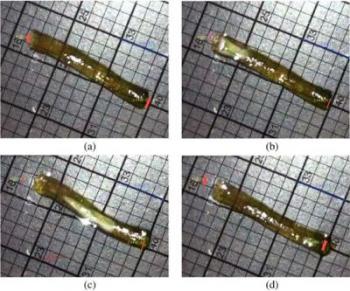May 31 2014
A prestigious journal published a UC undergraduate's research on hydrogels a special substance that can be equipped to detect bacteria, carry cargo and deliver medicine
 This set of images shows a free-floating hydrogel (2.6 cm in length) moving through water as it shrinks and swells. Credit: Photo provided by Jarod Gregory
This set of images shows a free-floating hydrogel (2.6 cm in length) moving through water as it shrinks and swells. Credit: Photo provided by Jarod Gregory
Next time you spot an earthworm sliding through fresh dirt, take a closer look. What you're seeing is an organic movement called peristaltic locomotion that has been meticulously refined by nature.
Jarod Gregory, an undergraduate student in the University of Cincinnati's College of Engineering and Applied Science, used a worm's contracting and expanding motion to provide a way for gels to swim in water. This is a product of work by the interdisciplinary team consisting of Jarod Gregory, a chemical engineering major, and his two advisers, Lilit Yeghiazarian, assistant professor of environmental engineering, and Vasile Nistor, assistant professor of biomedical engineering.
Phase one of his research titled, "Remote-Controlled Peristaltic Locomotion in Free-Floating PNIPAM Hydrogels," is published in the Journal of Applied Polymer Science.
Published research is always an accomplishment within the world of academia, but it is especially significant when the primary author is an undergraduate student at the time of his research. Gregory is an ACCEND (ACCelerated ENgineering Degree) student who has just transitioned directly into UC's doctoral program in environmental engineering last month after earning a bachelor's of science in chemical engineering. This not-so-common achievement as an undergrad points to the significance of Gregory's research, also recognized by this year's Goldwater Award.
When earthworms use peristaltic locomotion they engage with a surface, propel forward and detach. Gregory explains that peristaltic motion has previously been used by the team as a mechanism for movement for gels in frictional environments such as on solid ground or inside a tube. With Gregory's research, soft materials now have the ability to move freely without requiring outside friction, by using shrinking and swelling to move the center of gravity of an object in water - vastly expanding potential applications of soft materials and soon, soft robots.
Gregory explains, "Using a hand-held laser, we were able to selectively and quickly shrink the hydrogel (a hydrophilic polymer gel comprised mostly of water) in desired areas. By inducing a shrinking/swelling cycle down the length of a hydrogel, we were able to successfully mimic peristaltic, or earthworm-inspired, locomotion in water."
According to Gregory, "Studies have shown that hydrogels can be equipped to detect bacteria, carry cargo and deliver medicine. This new method of mobility expands the hydrogel's use as an environmental and biotechnological tool by allowing them to explore new areas such as surface waters to combat toxic elements, or cavities inside the human body."